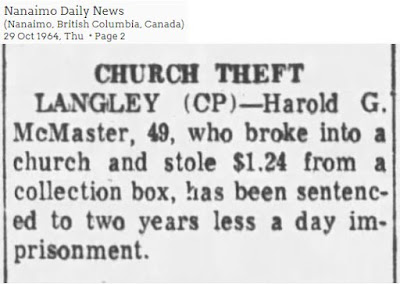Our story of the following Boot Hill Cemetery convict leads us on a chase across the continent, starting in the Eastern Canada, dipping into the United States of America, and then north to Western Canada in Vancouver, B.C. This seventeenth blog about the convicts buried at the forgotten cemetery, belonging to the razed B.C. Penitentiary in New Westminster, B.C., carries with it mystery. Hopefully we'll gain some understanding of who this man was and why he ended up buried in the sacred acre of land.
Meet Convict #3237 - Harold Gordon McMaster
 |
| Photo by Kati - Convict #3237 (3rd row from NW top section, farthest N position) |
Harold was born on June 09, 1915 to Amelia McMaster in Fairville area of the City and County of Saint John, in Lancaster Parish, New Brunswick, Canada.
 |
| Courtesy New Brunswick Archives - Birth Certificate |
 |
| Courtesy Prov.Archives of New Brunswick - Death Certificate |
 |
| Courtesy Prov.Archives of New Brunswick - Map of Fairville & St. John County (Date Unknown) |
 |
| Courtesy Prov.Archives of New Brunswick - Map of Fairville including Manawaganish Rd. (Date Unknown) |
 |
| Courtesy New-Brunswick.net - 1929 aerial of Saint John, New Brunswick |
During the First World War, the city was a trans-shipment point for the British Empire's war efforts. During the Second World War, due to the U-boat threat, it shifted it's focus to producing veneer wood for the De Havilland Mosquito bomber aircraft, and fortified itself with additional batteries installed around the harbour. In the 1970s an urban renewal project redeveloped the city and put in a new harbour bridge and expressway, moving the ferry terminal, opening up historic buildings to shops and museums, and building new office towers. In 1982 the Uptown area was designated for historic preservation. Today the waterfront is a tourist area. Saint John grew up on fishing and shipbuilding, but also boasts a long history of brewers; and is a creative hub for musicians, actors and artists, with many galleries and museums present, as well as numerous historic landmarks named in the National Historical Sites of Canada listings.
At the age of 24, we learn Harold Gordon McMaster found himself in trouble.
 |
| Courtesy Newspapers.com - Escanaba Daily Press, Michigan (Apr.28, 1939) pg01 |
 |
| Courtesy Newspapers.com - Ironwood Daily Globe, Michigan (Apr.29, 1939) pg07 |
 |
| Courtesy Ancestry.ca - Border Crossing at Detroit, Michigan (Feb.15, 1939) |
 |
| Courtesy Ancestry.ca - Border Crossing at Detroit, Michigan (Feb.15, 1939) |
Asylums popped up everywhere in the late 1800s, and reports of crude treatment were vast. In the 1930s, the economic depression strengthen the support for eugenic sterilization in Canada and the USA; however, a new wave of thinking had begun, leading to an array of self-help groups such as Alcoholics Anonymous, and those that supported healthier life-styles and dietary habits. It didn't, however, stop the inhuman treatment of those suffering, and singled out minority groups (IE: indigenous peoples).
Did Harold spend time in an asylum? I could not find any documentation to support this.
Harold spent five years in Marquette Branch Prison, which was built in 1889, and was riddled with notorious stories of escape attempts, bloodshed, the murder of its Warden in 1921, and the murder of a doctor in 1931. In 1977 it was listed in the National Register of Historic Places, and became a tourist attraction over the years due to its landscaping.
 |
| Courtesy Michigan Dept. of Corrections - Marquette Branch |
 |
| Courtesy Ancestry.ca - Border Crossing at Buffalo, NY (Aug.19, 1944) |
 |
| Courtesy Ancestry.ca - Border Crossing at Buffalo, NY (Aug.19, 1944) |
A few days later, Harold (aged 29 years old) attempts to cross the border at Niagara Falls, New York.
 |
| Courtesy Ancestry.ca - Border Crossing at Niagara Falls, NY (Aug.21, 1944) |
 |
| Courtesy Ancestry.ca - Border Crossing at Niagara Falls, NY (Aug.21, 1944) |
 |
| Courtesy Google Maps - Eastern Canada/USA showing places documented |
Next we locate Harold Gordon McMaster in the west of the continent. Harold has finally made his journey to Washington State and British Columbia two years later.
 |
| Courtesy Ancestry.ca - Border Crossing at Northport, WA (Oct.02, 1946) |
Northport, WA is on the mighty Columbia River in the north-eastern part of the State. Crossing the border would have placed him near the British Columbia communities of Rossland and Trail. The area is in the West Kootenay region surrounded by mountains. As documented, his trip would take 2 days to Vancouver, B.C. Harold is 31 years old at this time. The trail of Harold's life journey runs dry at this point until 1950.
 |
| Courtesy Ancestry.ca - Border Crossing at Blaine, WA (Sep.20, 1950) |
News comes to us about Harold's arrest in Vancouver, B.C. via the papers in 1954.
 |
| Courtesy Newspapers.com - Vancouver Sun (Nov.19, 1954) pg01 |
 |
| Courtesy Newspapers.com - Nanaimo Daily News (Nov.20, 1954) pg12 |
 |
| Courtesy New Brunswick Archives - Death Certificate, Catherine McMaster |
We next are brought to a crime Harold committed in Regina, Saskatchewan in 1957. This leads us to believe the crime in 1954 probably brought him 1-3 years in prison.
 |
| Courtesy Newspapers.com - Leader-Post (Jul.26, 1957) pg05 |
I found a legal document advising us of Harold's next conviction.
 |
| Courtesy BCLaws.ca - April 14, 1960 |
 |
| Photo by Kati (2016) - Essondale (Riverview) Hospital, 1913-2012 |
 |
| Courtesy Government of B.C. - Oakalla Prison Farm - 1912-1991 |
 |
| Courtesy Newspapers.com - Vancouver Sun (Feb.03, 1961) pg02 |
 |
| Courtesy Newspapers.com - Vancouver Sun (Oct.27, 1964) pg08 |
 |
| Courtesy Newspapers.com - Nanaimo Daily News (Oct.29, 1964) pg02 |
It appears to be a pattern. Harold resorts to theft and robbery in order to survive, and often finds prison the better option than living on the streets.
This also means he didn't serve a full 5 years at Kingston, and made his way back to the west. I wonder if he was released due to good behaviour? Often, when the prisons become overcrowded they consider letting some criminals with lesser crimes out.
A year later, Harold was transferred to Essondale Provincial Mental Hospital (now referred to as Riverview on the documents), and several months later is transferred back to Oakalla Prison.
 |
| Courtesy BCLaws.ca - Oct.14, 1965 |
 |
| Courtesy BCLaws.ca - Dec.21, 1965 |
Harold found himself in trouble one last time.
 |
| Courtesy Newspapers.com - Vancouver Sun (Feb.19, 1968) pg27 |
From the documentation on his Death Certificate, he died at Chilliwack Hospital at the age of 51 years, due to aspiration of stomach contents. In other words, he chocked to death. There are several reasons for this to occur, impaired mental status being one. The certificate also indicates a gastric ulcer, which may have been due to lengthy use of medication and/or infection and would have been very painful.
The certificate also confirms Harold had been in Matsqui, B.C. (which is in the area of Agassiz and the prison) at the time he was transferred to Chilliwack.
 |
| Courtesy B.C. Archives - Death Certificate |
I thank you for joining us on this journey of discovery and education about the convicts buried at the old B.C. Penitentiary Cemetery known as Boot Hill. The cemetery has undergone a transformation with the long grasses, weeds and brambles removed, and the old grave markers replaced with new numbered stones. A path leads up to the sacred plot of land which sits on a slope overlooking parts of New Westminster, B.C. and the Fraser River below.
If you have not read any of our previous accounts, please check them out. Each convicts' story is filled with interesting facts, incredible adventures and emotional effect.
01) Meet Convict 1548 - Thompson
02) Meet Convict 2370 - Walsh
03) Meet Convict 2304 - Chinley
05) Meet Convicts 1628 - Herman Wilson + Unknown# - Joseph Smith
06) Meet Convict 1659 - Y. Yoshie
07) Meet Convict 1884 - Moses Paul
08) Meet Convict 2516 - Daniel Henrick Urick
09) Meet Convict 1948 - Unknown Gim
10) Meet Convict 2938 - Reginald John Colpitts
11) Meet Convict 5603 - Stephen Poole
12) Meet Convict 3130 - Harry Davis
13) Meet Convict 2312 - Albert Hill
14) Meet Convict Unknown# - Phillip Hopkins
15) Meet Convict #9720 - Norman Donald Bottineau
16) Meet Convict #2225 - Louie Num
17) Meet Convict #3237 - Harold Gordon McMaster
18) Meet Convict #4234 - Herbert Ross
19) Meet Convict #9693 - W. Black
20) Meet Convict #6651 - Gordon Wallace
21) Meet Convict #9511 - Henry Gordon Wichmann
22) Meet Convict #3348 - Frank Wilson
20) Meet Convict #6651 - Gordon Wallace
21) Meet Convict #9511 - Henry Gordon Wichmann
22) Meet Convict #3348 - Frank Wilson
Please join us on Facebook and/or send us your comments via our Website. We'd love to hear from you, and certainly share any information you have about this graveyard. We are happy to learn what you know.
If you are interested in listening to the EVPs we captured at the cemetery over the years, go here (bottom of the page).
Lastly, if you visit the cemetery, please remember to be respectful. It doesn't matter who these men were in life, as everyone deserves to rest in peace. Hopefully our convicts have found that in their afterlife. If not, perhaps our stories about them will help them to move on.
Until next time,
Kati
Sources: New Brunswick Archives; new-Brunswick.net; Ancestry.ca; Wikipedia; Google Maps; Newspapers.com; BC Archives; UBC Open Sessions; DailyColonist.ca; Vancouver Public Library; Vancouver City Archives; Canadian Encyclopedia; SaintJohn.ca; BCLaws.ca; Provincial Archives of New Brunswick; Inflationcalculator.ca; Four Walls in the West - Jack David Scott: Serving Life25, One Guard's Story - Neil D. MacLean; Government of B.C..
Photos by Kati - do not use/copy or distribute without written permission of Kati Ackermann Webb @ vancouverspooks.com














No comments:
Post a Comment